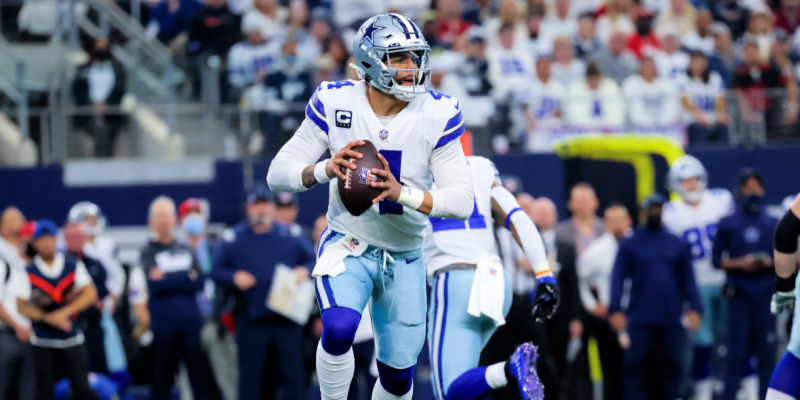Analysis
2/21/22
6 min read
Exploring The Successes and Failures Of The Franchise Tag

Tuesday, February 22 is the first day that NFL teams are allowed to use the franchise tag on an impending unrestricted free agent. This period extends for two weeks until March 8th at 4 pm ET. Some fans know the general idea of the franchise tag — the player is obligated to stay on the team and cannot hit the open market — but most do not understand why players are so against it or how the cap figures are calculated. Article 10 of the NFL-NFLPA Collective Bargaining Agreement lays out all of the necessary information to understand the franchise tag.
What is the franchise tag?
Technically, there are two forms of the franchise tag: 1) the non-exclusive franchise tender and 2) the exclusive franchise tender. With the non-exclusive tender, the player may still negotiate with other teams as if he were an unrestricted free agent, but the team signing the player would have to give the player’s former team two first round picks.
With the exclusive rights tender, the player may not negotiate with other teams. He will be given a fully guaranteed contract with a length of one year for an amount equal to the average of the five largest salaries from that league year for the position in which the player participated in the most plays during the prior league year. If a player is franchise tagged for a second year in a row, he will get the larger of the average described above and 120% of the player’s prior year salary. If it happens a third year in a row, he will get the larger of (1) the average of the five largest prior year salaries for players at the position with the highest such average — normally the quarterback average — (2) 120% of the average of the five largest prior year salaries for players at the same position, and (3) 144% of the player’s prior year salary.
The team may only use either the franchise or transition tender once per year. If the team decides to withdraw the tender at any time before the player signs it, they lose their use of the tenders for that year. Once a team revokes the tender, the player becomes an unrestricted free agent and they can begin negotiating with any and all teams that are interested.
Once a team uses the franchise tender on a player, the parties only have until 4 pm ET on July 15th to sign a multi-year contract or an extension beyond the one year franchise tender. After that date, the parties cannot agree to any multi-year contracts or extensions until after the team’s final regular season game of that season. They can only sign a one year contract for that season.
Why players dislike the franchise tag
Players are often against signing the franchise tag for many reasons. The players who get tagged are generally the best players at their position who are set to hit the open market at the start of the league year. Therefore, they would likely get multi-year deals with far more fully guaranteed money than they do when they are tagged. These extra years also provide the players with a sense of stability, knowing where they are going to live and the system they will play in from season to season.
A player on the open market also gets to choose where they end up. This may seem pretty obvious, but when you factor this into situations like Davante Adams’ in Green Bay, the player has a variety of considerations when making their free agency decision.
In Adams’ case, there are question marks about who the quarterback of the future will be, let alone the quarterback of 2022. The Packers obviously want Adams there regardless of who their quarterback is. Pairing him with Aaron Rodgers has been a dynamic duo the past 8 seasons. On the other hand, who could be better to pair with a first time starter in Jordan Love than someone with 110+ receptions and 1350+ yards 3 of the last 4 seasons? Yet, with Rodgers entering the final few years of his playing career, would Davante even want to stay in Green Bay on a long term deal anyway? Not to mention other competing factors such as the brutal winters at Lambeau Field or the impending 2023 free agent quarterback in Las Vegas whom Adams played college ball with and has spoken publicly about their friendship.
Similar situations in the past
While some players wound up reaping the benefits of a top 5 fully guaranteed salary before cashing in the following season, others have lost significant value on the free agency market the year following being tagged. The following situations should be looked at through the lens of a player and his agent.
“Successes”:
- QB Dak Prescott
Prescott was tagged in 2020 for $31,409,000. Prior to the 2021 season, the Cowboys rewarded him with a four-year, $160 million contract which included a $66 million signing bonus. Including Dak’s 2021 base salary, he received just over $100 million in cash between his franchise tag year and the first season of his multi-year contract.
- OLB Shaq Barrett
Barrett was tagged in 2020 for $15,828,000. Like Prescott, he was rewarded by the same team that tagged him with a four year deal worth $68 million, including a $18,750,000 signing bonus. In all, he took home just under $35 million in cash over his franchise tag season and the first season of his multi-year contract.
- QB Kirk Cousins
During Cousins’ time in Washington, he was tagged twice — once for $19,953,000 and another for $23,943,600. In 2018, after Washington decided not to tag him for a third time, which would have cost $34,478,784, the Vikings signed Cousins to a fully guaranteed three-year deal worth $84 million. All in all, Cousins took home nearly $128 million fully guaranteed over the past 5 seasons.
“Failures”:
- DE Jadeveon Clowney
Clowney was tagged by the Texans prior to the 2019 season and would have been paid $15,967,000. However, he held out and refused to attend mandatory training camps, later demanding a trade. The Texans obliged and sent him to Seattle for a third round pick and two players. Clowney played under the tag during the 2019 season and did not re-sign with the Seahawks. He was signed to a one year deal by the Titans prior to the 2020 season for $13 million. This past season played for this third team in as many years after being picked up by the Browns on another one year deal, this time worth just $8 million. Since being tagged and subsequently holding out, he has signed three different deals worth a total $36 million. Compare this to the Shaq Barrett situation above (where he stayed on the same team and made the same amount of cash as Clowney in one less season) and you can see why players are significantly averse to the franchise tag.
- S Anthony Harris
Harris was tagged by the Vikings prior to the 2020 season and made $11,441,000. In 2020, he allowed career highs as a starter in yards, yards per reception, touchdowns allowed, passer rating when targeted, and missed tackles. After 2020 the Vikings declined to re-sign the veteran safety and he hit the open market, eventually signing a one year $4 million deal with the Eagles. He will now hit free agency again this offseason at the age of 30 coming off the two worst seasons of his career.








